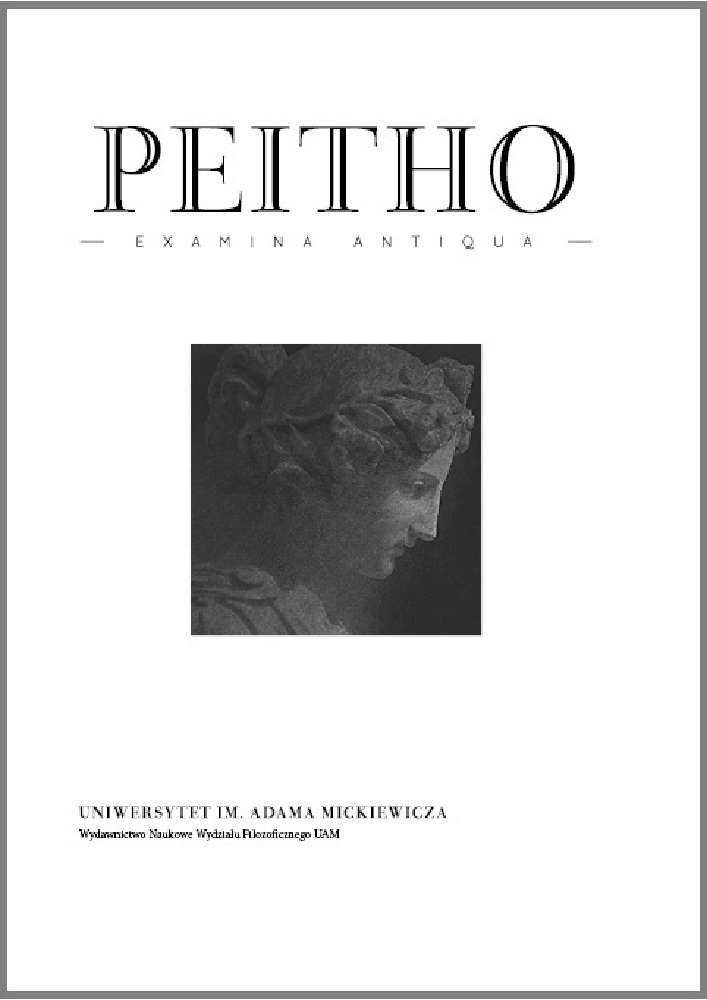Abstract
The aim of this study is to discuss an original philosophical contribution made by Philoponus, who in In Cat. 18, 14–22 equates koinon in its most peculiar meaning with the concept of koinônia understood as a particular case of Platonic methexis. First, the paper analyzes the passages where the Neoplatonic commentators of the Categories distinguish four distinct meanings of the Aristotelian concept of koinon. Subsequently, this article emphasizes the differences between Philoponus’ hermeneutical suggestions and those of the other commentators. Philoponus clarifies that while every koinon is methekton, Aristotle’s koinon is characterized by the fact that the participation is ex isou and kata meros. Thus, koinônia, according to Philoponus, is a particular case of methexis, where everyone participating in something participates in it equally and singly. The example cited by Philoponus to explain Aristotle’s koinon is that of men participating equally and singly in human nature. The study concludes with a discussion of the relationship among the concepts of koinon, koinônia and methexis.
References
Barnes, J., 2003, Porphyry’s Introduction, Oxford.
Bodéüs, R., 2008, Porphyre, Commentaire aux “Catégories” d’Aristote, Paris.
Busse, A., (ed.), 1887, Porphyrius, Isagoge et in Aristotelis Categorias commentarium, CAG IV 1, Berolini.
Busse, A., (ed.), 1895, Ammonius, In Aristotelis Categorias commentarium, CAG IV 4, Berolini.
Busse, A., (ed.), 1898, Philoponus, In Aristotelis categorias commentarium, CAG XIII 1, Berolini.
Busse, A., (ed.), 1902, Olympiodorus, Prolegomena et In Categorias commentaria, CAG XII 1, Berolini.
Chase, M., (transl.), 2003, Simplicius, On Aristotle’s Categories 1–4, London – New York.
Chiaradonna, R., 2002, Sostanza, Movimento, Analogia. Plotino critico di Aristotele, Napoli.
Chiaradonna, R., 2004, “Plotino e la teoria degli universali. Enn. VI 3 [44], 9”, in: V. Celluprica, C. D’Ancona (cur.), Aristotele e i suoi esegeti neoplatonici. Logica e ontologia nelle interpretazioni greche e arabe. Atti del Convegno internazionale Roma 19–20 ottobre 2001, Napoli, pp. 3–35.
Chiaradonna, R., 2007, “Porphyry and Iamblichus on Universals and Synonymous Predication”, Documenti e studi sulla tradizione filosofica medievale 18, pp. 123–140.
Chiaradonna, R., 2008, “What is Porphyry’s Isagoge?”, Documenti e studi sulla tradizione filosofica medievale 19, pp. 1–30.
Chiaradonna, R., Rashed, M., Sedley D., Tchernetska, N., 2013, “A Rediscovered Categories Commen¬tary”, Oxford Studies in Ancient Philosophy 44, pp. 129–194.
Cohen, S. M., Matthews, G. B. (trans.), Ammonius, 1991, On Aristotle’s Categories, London – Ithaca.
De Haas, F. A. J., 2001, “Did Plotinus and Porphyry disagree on Aristotle’s Categories?”, Phronesis 46, pp. 492–526.
De Libera, A., 1999, Il problema degli universali, Firenze.
Erismann, Ch., 2011, L’homme commun. La gènese du réalisme ontologique durant le haut Moyen Âge, Paris.
Fronterotta, F., 2001, ΜΕΘΕΞΙΣ. La teoria platonica delle idee e la partecipazione delle cose empiriche. Dai dialoghi giovanili al Parmenide, Pisa.
Giardina, G. R., 2006, I fondamenti della causalità naturale. Analisi critica di Aristotele, Phys. II, Catania.
Girgenti, G., 1996, “L’interpretazione porfiriana di Platone e Aristotele”, in: G. Girgenti, Il pensiero forte di Porfirio. Mediazione fra henologia platonica e ontologia aristotelica, Milano, pp. 113–124.
Kalbfleisch, C. (ed.), 1907, Simplicius, In Aristotelis Categorias commentarium, CAG VIII, Berolini.
Kroll, G., (ed.), 1899–1901, Procli In Platonis Rem publicam commentarium, Leipzig [rist. Amsterdam 1965].
Linguiti, A., 2005, Dottrina delle idee nel neoplatonismo, in: F. Fronterotta, W. Leszl (cur.), Eidos-Idea. Platone Aristotele e la tradizione platonica, Sankt Augustin, pp. 247–261.
Lloyd, A. C., 1998, The Anatomy of the Neoplatonism, New York [I ed. 1990], pp. 4–6.
Luna, C., 1990, Simplicius. Commentaire sur les Catégories, Fasc. III: Préambule aux Catégories; Commentaire au premier chapitre des Catégories (P. 21–40, 13 Kalbfleisch), Leiden.
Mannsperger, D., 1969, Physis bei Platon, Berlin.
Narcy, M., 1980, Qu’est-ce qu’une figure? Une difficulté de la doctrine aristotélicienne de la qualité (Catégories 8, 10b26–11a14), in: P. Aubenque (éd.), Concepts et catégories dans la pensée antique, Paris, pp. 197–216.
Narcy, M., 1981, “L’homonymie entre Aristote et ses commentateurs néoplatoniciens”, Les Études philosophi¬ques 1, pp. 35–52.
Pellegrin, P., Crubellier, M., Dalimier C. (trad.), 2007, Aristote, Les Catégories. Sur l’interprétation. Orga¬non I–II, Paris.
Pelletier, Y. (trad.), 1983, Les attributions (Catégories): le texte aristotelicienne e les prolégomènes d’Ammonios d’Hermeias, Montreal – Paris.
Romano, F., 1983, “Lo ‘sfruttamento’ neoplatonico di Aristotele”, in: F. Romano, Studi e ricerche sul Neoplato¬nismo, Napoli, pp. 35–47.
Romano, F., 1983b, “Il Platonismo della tarda antichità: neoplatonismo e nuove forme di teoresi platonica”, in: F. Romano, Studi e ricerche sul Neoplatonismo, Napoli.
Romano, F., 1998, Il Neoplatonismo, Roma.
Romano, F., 2011, “In che modo Platone ha ereditato e trasformato la φύσις dei Presocratici”, in: L. Palumbo (cur.), Λόγον διδόναι. La filosofia come esercizio del render ragione. Studi in onore di Giovanni Casertano, Napoli, pp. 349–360.
Romano, F., 2012, Discorso e realtà dell’universo. Giamblico esegeta di Aristotele, Catania.
Smith, A. (ed.), 1993, Porphyrius, Fragmenta, Lepzig.
Tannery, P., 1897, “Sur la locution ἐξ ἴσου“, Revue des Études Grecques 10, pp. 14–18.
Zanatta, M., 1989, Le Categorie, Milano.
License
Peitho provides immediate open access to its content on the principle that making research freely available to the public supports a greater global exchange of knowledge.
